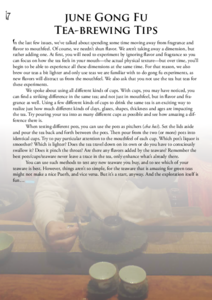
 |
|
In the last few issues, we've talked about spending some time moving away from fragrance and flavor to mouthfeel. Of course, we needn't shun flavor. We aren't taking away a dimension, but rather adding one. At first, you will need to experiment by ignoring flavor and fragrance so you can focus on how the tea feels in your mouth - the actual physical texture - but over time, you'll begin to be able to experience all these dimensions at the same time. For that reason, we also brew our teas a bit lighter and only use teas we are familiar with to do gong fu experiments, as new flavors will distract us from the mouthfeel. We also ask that you not use the tea hut teas for these experiments.
We spoke about using all different kinds of cups. With cups, you may have noticed, you can find a striking difference in the same tea; and not just in mouthfeel, but in flavor and fragrance as well. Using a few different kinds of cups to drink the same tea is an exciting way to realize just how much different kinds of clays, glazes, shapes, thickness and ages are impacting the tea. Try pouring your tea into as many different cups as possible and see how amazing a difference there is.
When testing different pots, you can use the pots as pitchers (cha hai). Set the lids aside and pour the tea back and forth between the pots. Then pour from the two (or more) pots into identical cups. Try to pay particular attention to the mouthfeel of each cup. Which pot's liquor is smoother? Which is lighter? Does the tea travel down on its own or do you have to consciously swallow it? Does it pinch the throat? Are there any flavors added by the teaware? Remember the best pots/cups/teaware never leave a trace in the tea, only enhance what's already there.
You can use such methods to test any new teaware you buy, and to see which of your teaware is best. However, things aren't so simple, for the teaware that is amazing for green teas might not make a nice Puerh, and vice versa. But it's a start, anyway. And the exploration itself is fun...